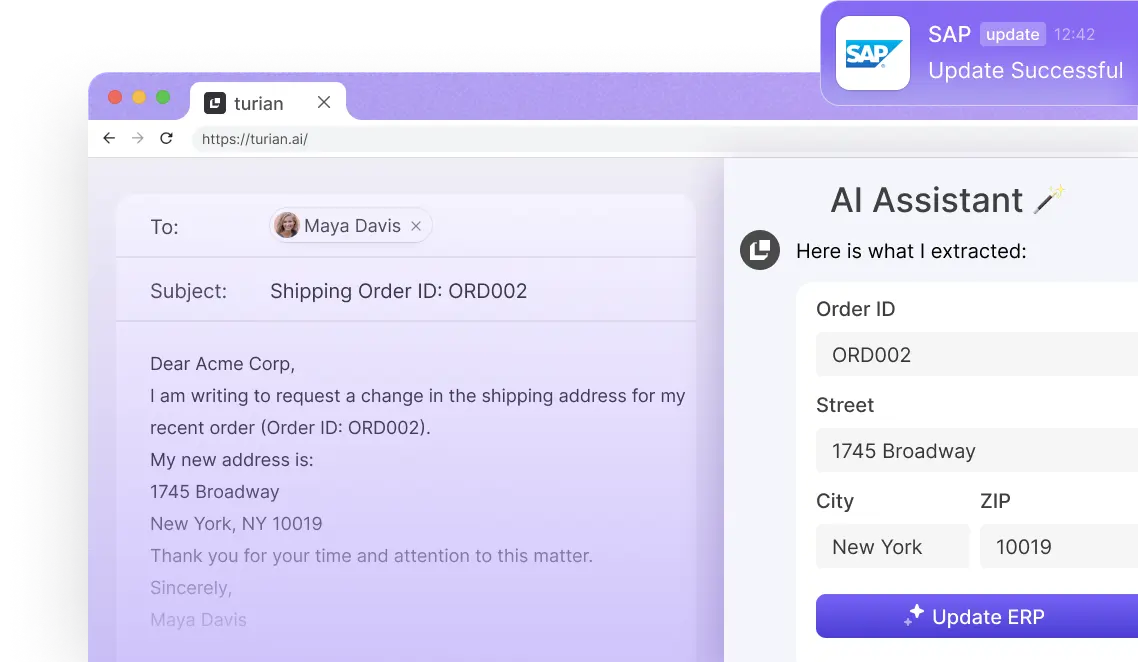

E-Invoice: The Basics & How To Automate E-Invoice Processing
E-Invoice will be mandatory from 2025 in the B2B sector in Germany. This digitalization of the invoicing process is not only a condition but also a great opportunity for companies to streamline their operations, save costs, and contribute to a greener future. But what exactly is E-Invoice? What changes will it bring to the business landscape? And how can companies prepare for this new legislation?
If these questions are on your mind, then keep on reading because this guide walks you through everything you need to know about E-Invoice so your business can transition smoothly into this new era of digital invoicing.
Let's start with the basics:
What Is An E-Invoice?

Image source: vectorjuice
An electronic invoice (or, in short, e-invoice) is a type of invoice that is created, sent, received, and processed in electronic formats. In other words, it is a digital version of the traditional paper invoice that is sent and received electronically (e.g. by email) in a predefined format rather than being printed and sent by post in a physical form. The entire process, from submitting invoices to their payment, is carried out digitally, without the need for any paper, printing, or postal services.
In the context of the new e-invoice law in Germany, E-Invoice is defined as structured electronic invoices that are created in a machine-readable format and comply with the European standard EN 16931. This means that they are not just any type of digital invoice but rather a specific format that is recognized and regulated by law, which we will discuss in more detail later on.
E-Invoice Pflicht From 2025: What Does It Mean for Businesses?

Image source: pch.vector
Ok. Now we know what E-Invoice is, but what does it actually mean for your business? Let's start by looking at the bigger picture. In recent years, companies have been automating and digitizing more and more processes, and this also includes invoicing. The reason behind this shift is quite simple - automating processes can help speed things up, reduce errors and costs associated with traditional paper-based methods, and ultimately lead to more efficient business operations.
And the same goes for invoicing. With e-invoicing, companies can now send and receive invoices in a fully digital manner, from start to finish. E-invoices are becoming increasingly popular around the world and are used in many countries as the standard method for invoicing. And now, following the example of other EU states and other third countries, Germany has also decided to introduce electronic invoicing.
This decision came with the approval of the Growth Opportunities Act in Germany, which was passed by the Bundestag and Bundesrat on March 22, 2024. With the implementation of this law, the federal government aims to boost Germany's attractiveness as a business hub, as well as strengthen the economy by improving cash flow, promoting growth, and creating incentives for investment and innovation while also further modernizing tax laws and streamlining the tax system.
But what does this all mean for businesses? In simple terms, it means that starting from January 1, 2025, all companieswill be legally required to accept e-invoices in Germany. This is known as the E-Invoice Pflicht (or mandatory e-invoicing), and it applies to all businesses, regardless of their size or industry. The main goal of this new regulation is to eliminate paper-based invoicing methods and move towards a fully digital economy.
What Will Change?
So, what exactly will change with this new legislation? Well, before everything else, you'll need to familiarize yourself with new definitions. From January 1, 2025, there will only be a distinction between two types of invoices: electronic invoices and other invoices. Let's take a look at each one:
Electronic Invoices
An electronic invoice (e-invoice) will be defined as an invoice that is created, sent, and received in a predefined, structured digital format. This data format must adhere to the European EN 16931 standard to ensure that the invoice can be processed electronically. In Germany, these are in particular the invoice formats “XRechnung” (standard format DE) and “ZUGFeRD” (international format), but also EDI / EDIFACT. What does this mean in practice? Well, for an invoice to qualify as an e-invoice, it must be structured in a specific way that allows for automated processing. Invoices in PDF or other non-standardized formats, such as DOCX or JPG, while great for representing the invoice visually, will not meet the conditions for automated processing and will, therefore, not be considered e-invoices as per the new law.
Other Invoices
If an invoice does not meet the criteria for an e-invoice, it will fall under the category of "other invoices." This includes paper invoices as well as those sent in any other electronic format like PDF, Word file, or JPG.
Who Does The Mandatory E-Invoice Affect?
Now, you may be wondering who exactly will be affected by this new mandatory E-Invoice. The short answer is that it primarily applies to taxable supplies and services between companies (B2B). Starting January 1, 2025, all companies in Germany will be legally required to accept electronic invoices (e-invoices). For the issuance of e-invoices, there are some further considerations: companies with an annual turnover exceeding 800,000 EUR must comply by December 31, 2026, while all remaining companies have until December 31, 2027, to transition to e-invoicing. No matter if the involved company is operating as its primary business or a secondary one, they are obligated to issue e-invoices. And not just them; by 2028, even small businesses that fall under the VAT category will have to comply with this new rule. Plus, both the service provider and recipient must be residents of Germany in order for the e-invoicing obligation to apply.
So, what does it mean to be a resident of Germany? According to the regulations, a company must have either a registered office, management, or permanent establishment in Germany to be considered a resident. If your business has no registered office but is managed from or has teams working in Germany, you still meet the residency requirement. However, if your business is simply VAT-registered in Germany without any physical presence, you are not obligated to submit electronic invoices.
Note: Sales to private end consumers (B2C) and cross-border B2B sales are not affected by the E-Invoice Pflicht. This means that if you are selling directly to consumers or are conducting business with companies outside of Germany, you do not have to worry about this new ordinance.
The Next Steps
Now, we have a clear understanding of what E-Invoice Pflicht is and who it affects. But what are the next steps for companies to comply with this new regulation? Well, here's a breakdown of what to expect in the coming years:
2025
According to the Growth Opportunities Act, from January 1, 2025, the E-Invoice Pflicht will become effective in Germany. This means that all businesses in the B2B sector must send and receive e-invoices in a standardized format that complies with the European standard series EN 16931.
2025 and 2026
During these two years, companies can still issue paper invoices for B2B sales, as well as electronic invoices (e.g. PDF) that do not comply with the European EN 16931 standard. However, the recipient of these non-compliant invoices must give their consent for them to be sent in this format.
2027
From January 1, 2027, companies that do not generate a turnover of more than 800,000 euros in the previous year can continue to send paper invoices. Businesses with a higher turnover can still use paper invoices, but only if they are transmitted via electronic data interchange (EDI) procedures.
2028
From January 1, 2028, all companies in the B2B sector must fully comply with the new requirements for electronic invoicing.
Which Formats and Formal Requirements Should You Look For
As we have said earlier, E-Invoice is not just any type of digital invoice—it must comply with specific standards and formats prescribed by the European Union. The specified format for e-invoices is a structured, XML data format. So, if a company wants to send electronic invoices, they must ensure that their invoices are in this format. This is because, unlike a scanned paper invoice or a PDF invoice which require manual processing, structured e-invoices allow for direct import of invoice data into further processing systems without the need for manual intervention.
In Germany, there are two approved standard formats for structured e-invoices: XRechnung and ZUGFeRD. Let's look at each of these formats in a little more detail:
XRechnung
The XRechnung standard is an XML-based format that was created by the Coordination Office for IT Standards (KoSIT) under the direction of the IT Planning Council. This format was created in response to the EU Directive 2014/55/EU and adopted into German law with the E-Invoice Law of April 4, 2017. The main purpose of the XRechnung standard is to facilitate the exchange of invoice data between companies and public administrations through automatic electronic processing.
ZUGFeRD
ZUGFeRD is another standard for electronic invoices that is recognized in Germany and meets the requirements of the EU directive. Unlike XRechnung, which solely focuses on structured, machine-readable data for automated processing, ZUGFeRD takes a hybrid approach. It combines both a visual representation of the invoice in a PDF file and structured data in XML format. This means that a ZUGFeRD invoice can be read not only by machines but also by humans due to its visual representation.
While currently only XRechnung and ZUGFeRD are officially recognized as standard formats for e-invoices in Germany, the EU directive allows for the use of other formats as long as they meet the required standards.
The Benefits of E-Invoice
E-Invoice may seem like an additional regulatory burden for businesses, but there are several benefits that come with it. Here are some of the key advantages of switching to electronic invoicing:
Cost Reduction
One of the most obvious advantages of using E-Invoice is that it can significantly reduce costs for businesses. Traditional paper invoices require a lot of resources, like paper, printing, enveloping, and postage. And let's not forget the manual processing time, which can take up a considerable amount of working hours. With E-Invoice, all these costs are greatly reduced as everything is done digitally. This results in cost savings for businesses, allowing them to allocate their resources to other important areas.
Improved Efficiency of Processes
In addition to cost reduction, using e-invoices can greatly improve the efficiency of processes within an organization. By eliminating the time-consuming manual processes like printing, enveloping, and posting, businesses can streamline their invoicing workflows and significantly speed up operations. This leads to faster processing and approval of invoices and reduces the overall invoice processing time. Plus, electronic invoicing reduces the likelihood of errors that can occur during manual data entry as all the data is automatically transferred from the electronic invoice to the business system.
Faster Payment Processing
As said earlier, e-invoicing can significantly speed up the processing and approval of invoices. Faster processing naturally translates to quicker payment collection, which directly benefits a company's cash flow. By using electronic invoicing, businesses can reduce payment cycles for outgoing invoices and ensure that they receive payments in a timely manner. This not only improves the company's liquidity but also helps maintain good relationships with clients and suppliers.
How To Automate E-Invoicing Processing with turian
If you're tired of spending hours manually processing electronic invoices, it's time to let turian take over. turian's e-invoicing solution uses cutting-edge AI technology, including large language models (LLMs) and natural language processing (NLP) to automate the e-invoicing process, from end to end. Our E-Invoice software can extract essential data from both e-invoices and traditional paper invoices, like invoice numbers, dates, line items, and amounts, with no need for manual input or model training.
But turian doesn't just stop at data extraction; our AI Assistants will also check the accuracy and validity of your e-invoices, ensuring that all legally required information, like sales tax, is included and correctly calculated. With turian's e-invoicing solution, companies can save time, reduce errors, and stay fully compliant with EU regulations such as EN 16931, 2014/55/EU.
turian's e-invoicing software can process e-invoices in legally defined formats (e.g. XRechnung and ZUGFeRD) so you can be confident that your e-invoices are compliant with EU standards. Plus, our solution visually displays the information in a human-readable layout, making it easy for your team to review and approve invoices. And, with seamless integration, turian can automatically transfer extracted data into your ERP system or accounting system in just seconds. With turian, you can have peace of mind knowing that your systems are always in sync and your financial data is complete.
If you want to see how turian's e-invoicing solution can automate your e-invoicing process, we offer a Proof-of-Concept (PoC). The best part? It is free without any obligation. So, if you're ready to take the first step towards efficient and compliant electronic invoicing, contact us today.
{{cta-block-blog}}

Say hi to your
AI Assistant!


Lernen Sie Ihren KI-Assistenten kennen!
.avif)
FAQ
The Growth Opportunities Act, officially known as the "Act to Strengthen Growth Opportunities, Investments, and Innovation as well as Tax Simplification and Fairness," is a German law passed by the Bundestag and Bundesrat on March 22, 2024. The main purpose of this law is to boost Germany's economy by promoting growth, creating incentives for investment and innovation, and modernizing tax laws. In simple terms, the Growth Opportunities Act is a bundle of initiatives that help businesses operate more efficiently and invest in Germany more easily.
The new E-Invoice legislation will come into effect on January 1, 2025. From this date, invoice issuers in Germany's B2B sector will be required to adopt sending electronic invoices as the standard practice for all transactions. Companies can still use paper invoices and certain electronic formats like PDFs during the transitional years of 2025 and 2026, but only if the recipient agrees to it. And by 2028, all companies in the B2B sector must fully comply with the new e-invoicing requirements.
turian's e-invoicing solution can help businesses comply with the new E-Invoice legislation by automating the e-invoicing process from end to end. Our AI solution can extract data from both electronic and paper invoices, check for accuracy and validity, and ensure compliance with EU regulations like EN 16931, 2014/55/EU. Plus, turian can process e-invoices in legally defined formats (e.g. XRechnung and ZUGFeRD) and seamlessly integrate with ERP and accounting systems for efficient data transfer. With turian, businesses can save time, reduce the likelihood of errors, and stay compliant with the new E-Invoice legislation.
ZRE is the abbreviation for Zentrale Rechnungseingangsplattform des Bundes, which is the Central Invoice Submission Portal of the Federal Government in Germany. This web application enables suppliers and service providers to submit e-invoices to the direct federal administration. There is also another portal for submitting e-invoices, called the Online Access Act-compliant Invoice Submission Portal (OZG-RE) which is used by many organizations of the indirect federal administration.
And if you don't have software for creating electronic invoices, you can use either of these portals depending on which federal contracting authorities you are dealing with. To do this, you input your invoice data into the submission portal through your web browser and then submit this data as an e-invoice. But it's not as easy as it sounds. It requires a lot of manual effort, and the probability of errors is high. For more information on e-invoicing, you can visit ZRE's official website.





